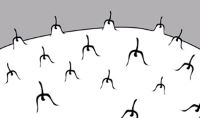Content is from Kirkbride et al. 2006Kirkbride et al. 2006:
Kirkbride JH, Jr, Gunn CR, and Dallwitz MJ. 2006. Family guide for fruits and seeds, vers. 1.0. Accessed September 2020-January 2022. URL: https://nt.ars-grin.gov/seedsfruits/keys/frsdfam/index.cfm ., without modification.
Updates are forthcoming.
Fruits: Pistil(s) simple; 2–5; 1-pistillate. Fruit pericarpium; simple; carceruluscarcerulus:
simple, multicarpellate, indehiscent fruit consisting of one or more seeds and air space enclosed by an undifferentiated pericarp (Spjut 1994)
(Spjut Fig. 16D); without persistent central column; not within accessory organ(s); 1-seeded; 1-seeded; from 5.1–10 cm long to more than 10 cm long; 7–11 cm long; with 1-carpellate; not sulcatesulcate:
surface relief—having one or more elongate, relatively narrow and shallow depressions or grooves ; in transection flat (tened); apexapex:
; in transection flat (tened); apexapex:
the point farthest from the point of attachment, or the "tip" of an organ beaked; apexapex:
beaked; apexapex:
the point farthest from the point of attachment, or the "tip" of an organ long beakedbeak:
long beakedbeak:
a usually firm, terminal appendage, sometimes tapered (up to 2.5 cm); wall leatheryleathery:
(up to 2.5 cm); wall leatheryleathery:
texture—moderately thick, tough, and very pliable
; indehiscentindehiscent:
not opening on its own, as in a fruit
 . Epicarpepicarp:
. Epicarpepicarp:
outer layer of fruit wall or pericarp, if divided into layers; note here used synonymously with exocarp brown (all shades), or black (ish-brown); dulldull:
brown (all shades), or black (ish-brown); dulldull:
reflecting only a low proportion of incident light, with no apparent sheen ; durable; leatheryleathery:
; durable; leatheryleathery:
texture—moderately thick, tough, and very pliable
; glabrousglabrous:
without hairs
; without armature; not smooth; furrowed and ridgedridged:
surface relief—raised, thick ridges, sharp edged or rounded, usually in a series that may cover the entire surface (& pustulatepustular:
(& pustulatepustular:
surface relief—with small blisters or pustules on beakbeak:
on beakbeak:
a usually firm, terminal appendage, sometimes tapered ); without wing(s); without apicalapical:
); without wing(s); without apicalapical:
at or pertaining to the end of the seed or fruit distal from its point of attachment (i.e., base)
respiratory hole. Endocarpendocarp:
the inner layer of the pericarp, if divided into layers absent. Funiculusfuniculus:
absent. Funiculusfuniculus:
(alt. funicle) stalk connecting the ovule (later seed) to the ovary (later fruit) placenta short; short without seed bearing hookswith hooks:
short; short without seed bearing hookswith hooks:
bristles or spines with curved or backwards pointing tips, or with secondary bristles along their length (retinacula); not persisting in fruit after seed shed.
(retinacula); not persisting in fruit after seed shed.
Seeds: Arilaril:
(broad sense) appendicular structure that wholly or partly envelops a seed and is produced from or a modification of the funicle, raphe, or outer integument; usually fleshy or pulpy, sometimes spongy or tufted-capillate, often brightly colored absent. Seed larger than minute; 1 to less than 5 mm long; up to 20 mm long; in transection compressedcompressed:
absent. Seed larger than minute; 1 to less than 5 mm long; up to 20 mm long; in transection compressedcompressed:
flattened; in grasses, used to denote compression (not necessarily flattened) either laterally or dorsiventrally
; not bowl shaped; not nutlike; with winglike beakbeak:
a usually firm, terminal appendage, sometimes tapered (not winglike - revise answer); without caudatecaudate:
(not winglike - revise answer); without caudatecaudate:
tapering to a long, tail-like appendage appendage(s); at maturity without food reserves; without canavanine. Sarcotestasarcotesta:
appendage(s); at maturity without food reserves; without canavanine. Sarcotestasarcotesta:
pulpy or fleshy outer layer of the seed coat, simulates aril absent. Testatesta:
absent. Testatesta:
seed coat
 absent; without embryo surrounded and capped by viscid tissue. Embryo differentiated from food reserve; well developed; completely filling testatesta:
absent; without embryo surrounded and capped by viscid tissue. Embryo differentiated from food reserve; well developed; completely filling testatesta:
seed coat
 (no food reserve); at one end of seed not extending into a depression or cup; parallel to seed length; with cotyledons abruptly connected to hypocotyl-radicle; without coleorhiza; without simmondsin; without stomata; not green; with 2 or more cotyledons. Cotyledons 2; well developed; somewhat to significantly wider than hypocotyl-radicle; partially concealing hypocotyl-radicle; hemispheric; smooth; with apicesapex:
(no food reserve); at one end of seed not extending into a depression or cup; parallel to seed length; with cotyledons abruptly connected to hypocotyl-radicle; without coleorhiza; without simmondsin; without stomata; not green; with 2 or more cotyledons. Cotyledons 2; well developed; somewhat to significantly wider than hypocotyl-radicle; partially concealing hypocotyl-radicle; hemispheric; smooth; with apicesapex:
the point farthest from the point of attachment, or the "tip" of an organ notched; with margins separate; basally entire; equal in size; not punctatepunctate:
notched; with margins separate; basally entire; equal in size; not punctatepunctate:
surface relief—dotted with pits or with translucent, sunken glands or with colored dots, similar to pitted dotted. Hypocotyl-radicle well developed; straight; not thickened. Plumule well developed (& red); hooked; terminal between 2 cotyledons.
dotted. Hypocotyl-radicle well developed; straight; not thickened. Plumule well developed (& red); hooked; terminal between 2 cotyledons.
General references: Cronquist, A. 1981. An integrated system of classification of flowering plants, 1,262 p. Columbia University Press, New York, Engler, A. & K. Prantl. 1924 and onward. Die Natürlichen Pflanzenfamilimien. W. Engelman, Leipzig, Goldberg, A. 1986 (dicots) & 1989 (monocots). Classification, evolution, and phylogeny of the familes of Dicotyledons. Smithsonian Contr. Bot. 58 for dicots (314 pp.) & 71 for monocots (74 pp.). [Goldberg's illustrations are reproduced from older publications and these should be consulted], Gunn, C.R. & J.V. Dennis. 1976. World guide to tropical drift seeds and fruits, 240 pp. The New York Times Book Co., New York, Gunn, C.R., J.H. Wiersema, C.A. Ritchie, & J.H. Kirkbride, Jr. 1992 & amendments. Families and genera of Spermatophytes recognized by the Agricultural Research Service. Techn. Bull. U.S.D.A. 1796:1–500, Mabberley, D.J. 1987. The plant-book, 706 p. Cambridge University Press, Cambridge, and Martin, A.C. 1946. The comparative internal morphology of seeds. Amer. Midl. Naturalist 36:513–660.